- July 1, 2025
- Posted by: Shane Daly
- Categories: Stock Trading, Trading Article
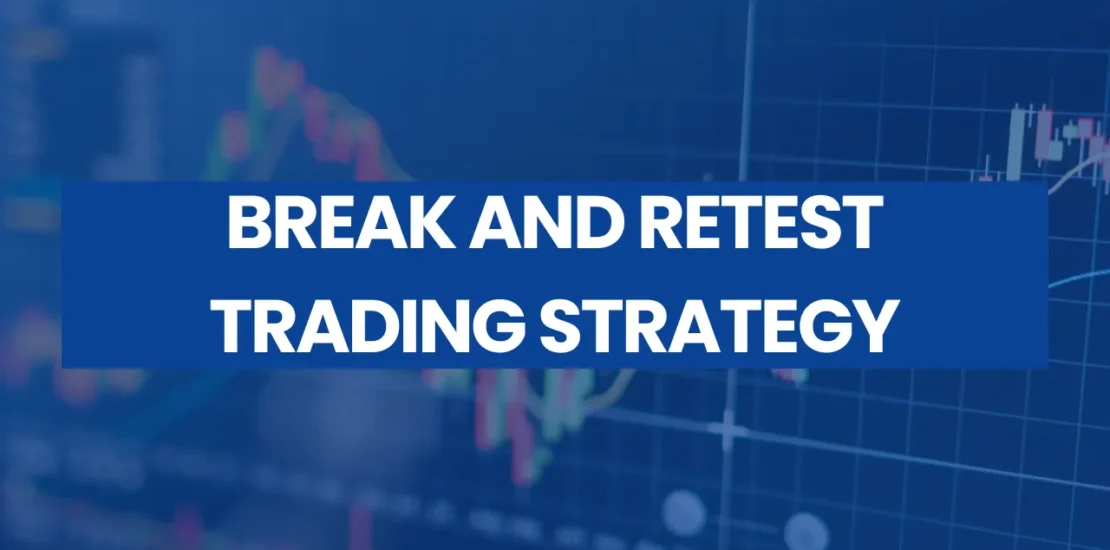
The power of break and retest patterns and how to profit from them requires mastering specific techniques. This strategy, which capitalizes on price action’s tendency to return to previous support or resistance levels after a breakout, can deliver consistent returns when executed properly. By learning to identify valid breakouts and confirmation signals, you’ll discover why professional traders rely on this time-tested approach to capture significant market moves.
TLDR
- Master identifying key support and resistance levels where price consistently bounces or reverses direction.
- Wait for clear breakout confirmation through increased trading volume and strong price momentum before entering trades.
- Enter positions when price returns to test previous support/resistance levels, confirming the validity of the breakout.
- Implement strict risk management by limiting position sizes to 2-3% and setting clear stop-loss levels.
- Use multiple timeframe analysis combined with technical indicators to validate trade setups and improve success rates.
What Is Break and Retest Trading?
Break and retest trading is a powerful strategy that relies on identifying key price levels where assets have previously shown significant support or resistance.
When prices break through these levels, their breakout significance increases as traders watch for a potential return to test the same level from the opposite direction.
You’ll want to focus on retest confirmation, which occurs when the price bounces off the former support or resistance level. This validates the breakout’s strength and often presents an ideal entry point for your trades.
The strategy works effectively across multiple timeframes, from daily charts to weekly analysis.
The key to break and retest trading is identifying an area of support or resistance where prices have repeatedly failed to advance. When this occurs, it shows that buyers or sellers are actively defending their positions, creating opportunities for traders to enter trades in the direction of the overall trend.
For example, this older chart of HARROW HEALTH (HROW) stock showed that that every time it reached a new resistance level of around $13.00 per share it was met with selling pressure.

After several attempts at breaking through this level HROW succeeded.
By recognizing this pattern early, traders with an eye for detail could have taken advantage of the break and retest setup by entering long trades once HROW surpassed $13-15 per share. Placing stop losses just below the prior resistance zone or deeper in the range, is essential to limit potential losses should prices reverse back.
Break and retest patterns serve as valuable tools for traders seeking to identify potential trading opportunities. The following section will explore how to spot these break and retest setups.
How to Identify Break and Retest Opportunities
By understanding these key support and resistance levels, traders can spot potential price reversals and set up profitable trading positions.
Looking for instruments that made a strong price move and is now consolidating, is one of the best ways to find these setups for a breakout strategy.

Moving averages are also useful when looking for breakout levels since they provide an average price over time which can be used as a reference point when analyzing chart patterns. Finally, simple trend lines can provide zones of opportunity for traders looking to trade the break and retest method.
What Is The Difference Between A Retest And A Pullback?
Retests and pullbacks are two similar but different types of market movements that can occur after a breakout.
A retest occurs when the price of an asset reaches a new high or low, but then quickly reverses back to test its previous level before continuing on with its original trend.
A pullback is when the price moves in the opposite direction from its original trend.
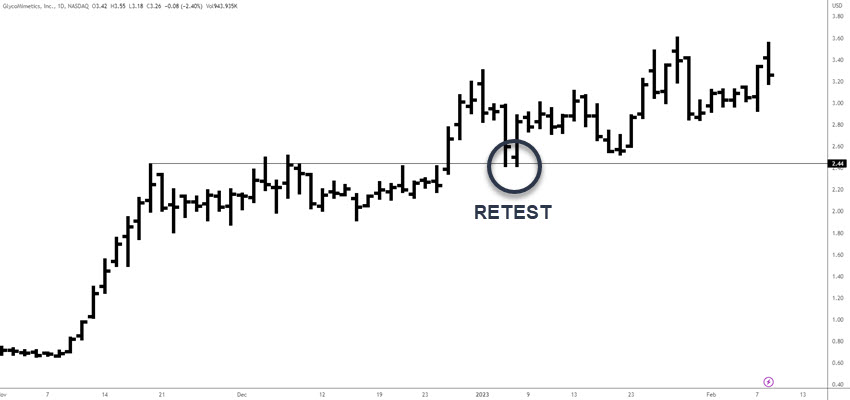
This type of movement can be seen as confirmation that the breakout was valid and not just a one-time event. Retests often provide traders with opportunities to enter positions at better prices than if they had entered immediately after the initial breakout.
Breakouts in the opposite direction can also be the beginning of a new trend and is something to consider if the current direction is showing exhaustion.
What Are Pullbacks?
Pullbacks are a trading strategy that provides traders with entry opportunities, although they should understand these entries may carry increased risk. Since pullbacks often move diagonally, finding an appropriate stop loss level can be challenging. These price movements typically form various patterns that emerge following a strong directional move.
When a large price move occurs, traders quickly enter positions, fueling the momentum. As price drives upward, those who entered early begin taking out wins. Eventually, price reverses as the upward momentum stalls due to increased selling pressure. Pullback traders then look to capitalize on the reversal.
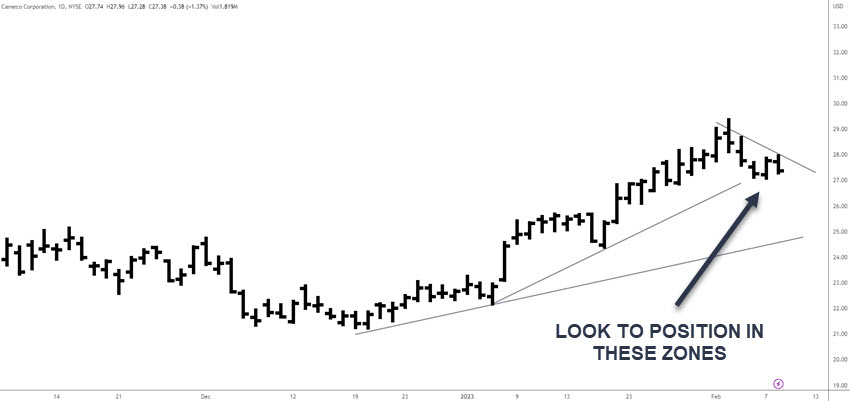
When trading breakouts, it is important for traders to understand both retests and pullbacks in order to identify potential opportunities for entering positions at favorable prices.
Breakout and Retest Strategy – Popular Trading Strategy
The breakout and retest strategy is a popular trading technique used by many traders that want confirmation that the break higher (or lower) will hold.
Traders can also use other technical indicators such as moving averages or oscillators like RSI (Relative Strength Index) along with trendlines and chart patterns like triangles or flags to help identify potential breakouts and retests more accurately.
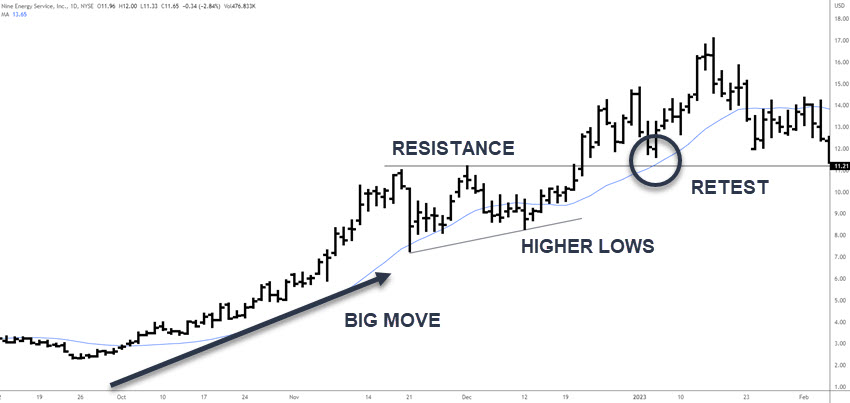
In this example we have:
- Large move (179%)
- Price making higher lows under resistance
- Break and retest of resistance zone
It is important for traders using this strategy to practice risk management techniques such as setting stop losses at sensible levels so they do not get caught up in runaway moves which can quickly turn against them.
Breakout and Retest Strategy is a powerful tool for traders to identify potential entry points in the market. By understanding how to properly execute this strategy, traders can capitalize on price movements and take advantage of opportunities in the markets.
Managing Risk in Break and Retest Strategy
Risk management forms the cornerstone of any successful break and retest trading strategy. To protect your capital, you’ll need to implement thorough risk assessment procedures before entering any trade.
Start by limiting your position size to 2-3% of your total trading capital, and always set stop-loss orders below support levels for long positions.
Your loss prevention strategy should include analyzing multiple timeframes to confirm breakout signals, measuring potential reward-to-risk ratios, and monitoring volume patterns.
Trading Breakouts That Fail
When trading breakouts, it’s important that you recognize potential failure signals before entering a position. One effective method is monitoring volume levels after the breakout occurs. If volume doesn’t increase substantially after price breaks out of its previous range, there’s a high probability that price will retrace back into that range – resulting in a failed breakout setup.
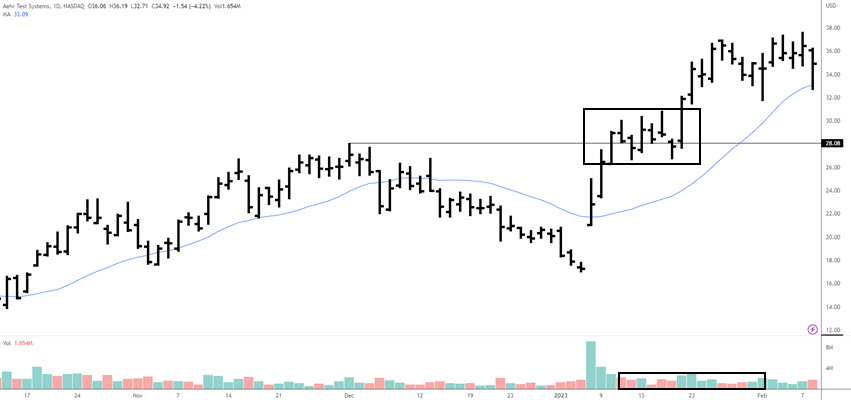
While this trade eventually moves higher after price action around the breakout area, it demonstrates several undesirable characteristics. There’s no volume increase following the break, no strong momentum away from the zone, and most importantly, the momentum driving the break originated from the bottom of the area. When looking for a break and retest long setup, seek consolidations near resistance and establish higher lows.
If you can identify a false breakout in the markets, it is important to manage your risk and position size accordingly. By understanding how to properly manage your risk when trading breakouts, you can be better prepared for success with your next trade.
Risk Management with Breakouts
When trading breakouts, risk management is key. A stop loss order can be used to protect against losses if the breakout fails. This type of order sets a predetermined price at which your position will automatically close in case the market moves against you.
Trailing stops are another tool for managing risk with break and retests as they allow traders to lock in wins while still allowing their positions to remain open if the trend continues.
Position sizing plays a huge role when trading retests since they carry more risk than other strategies. Traders should use smaller position sizes to prevent significant losses from impacting their overall portfolio performance. Rather than risking 10% of your capital on one trade, consider risking 2-3% and spreading it across multiple trades or different markets.
It is important to remember that there is no guarantee that any given breakout will be successful; therefore, traders should always exercise caution when entering into these types of trades and ensure they have an exit plan in place before committing capital to a trade.
Traders should avoid chasing after breakouts as this can lead to overtrading and increase exposure to unnecessary risks such as slippage or gaps in prices due to lack of liquidity during volatile times.
Your Questions Answered
How Long Should Traders Wait Before Confirming a Successful Retest?
You’ll want to wait at least 2-3 candlesticks after the initial retest before confirming its success.
Watch for price action that respects the new support or resistance level, along with healthy trading volume.
For daily charts, this means monitoring 2-3 trading days, while on shorter timeframes, you’ll need 2-3 periods of your chosen interval.
Don’t rush your confirmation, as patience prevents costly false signals and failed trades.
Can the Break and Retest Strategy Work Effectively in Cryptocurrency Markets?
Yes, the break and retest strategy works well in cryptocurrency markets, where volatile price action creates clear support and resistance levels.
Cryptocurrency trends often display strong breakouts followed by retests, making them ideal for this approach.
When combined with technical indicators like RSI and volume analysis, you can effectively identify valid breakouts from false ones in the crypto market’s 24/7 trading environment.
What Percentage of Breakouts Typically Result in Successful Retests?
While exact breakout success rates vary by market conditions, you can typically expect 35-45% of breakouts to result in successful retests.
Your odds improve significantly, up to 60-65%, when you combine multiple confirmation signals like increased volume and strong momentum indicators.
It’s important to remember that even failed breakouts can present profitable opportunities if you’re prepared to trade in the opposite direction.
Should Traders Adjust Their Strategy During High-Volatility Economic News Events?
During high-impact economic events, you’ll need to modify your break and retest strategy for improved volatility management.
Consider widening your stop-losses to account for larger price swings, and reduce your position size by 50% to protect your capital.
The economic impact of news events can create false breakouts, so it’s prudent to wait for market stability before executing trades, typically 15-30 minutes after announcements.
Are Break and Retest Patterns More Reliable in Specific Market Sectors?
Break and retest patterns tend to work best in sectors with established trend histories and consistent liquidity, such as technology and financial stocks.
You’ll find that sector performance often correlates with clear support and resistance levels, making trend analysis more reliable.
Traditional sectors like utilities and consumer staples typically show more predictable patterns, while volatile sectors like biotech may produce less dependable break and retest signals.
Conclusion
You’ve now learned how to effectively implement break and retest strategies in your trading toolkit. By combining technical analysis, proper risk management, and patient execution, you’ll be ready to capitalize on these high-probability setups. Remember to practice identifying key levels, confirm your entries with multiple indicators, and always protect your capital with stop losses. Start small, stay consistent, and you’ll unlock the profit potential of break and retest trading.
